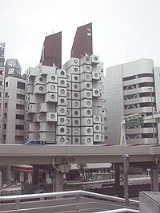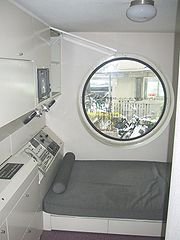
Nakagin Capsule Tower
Encyclopedia
The is a mixed-use residential and office tower designed by architect Kisho Kurokawa and located in Shimbashi, Tokyo
, Japan
.
Completed in 1972, the building is a rare built example of Japanese Metabolism, a movement that became emblematic of Japan's postwar cultural resurgence. The building was the world's first example of capsule architecture built for actual use. The building is still in use as of 2010, but has fallen into disrepair.
 The original target demographic were bachelor salarymen. The compact apartments included a wall of appliances and cabinets built in to one side, including a kitchen stove, a refrigerator, a television set, and a reel-to-reel tape deck
The original target demographic were bachelor salarymen. The compact apartments included a wall of appliances and cabinets built in to one side, including a kitchen stove, a refrigerator, a television set, and a reel-to-reel tape deck
. A bathroom unit, about the size of an aircraft lavatory
, is set into an opposite corner. A large circular window over a bed dominates the far end of the room.
Construction occurred on site and off site. On-site work included the two towers and their energy-supply systems and equipment, while the capsule parts were fabricated and the capsules were assembled at a factory.
The capsules were fitted with utilities and interior fittings before being shipped to the building site, where they were attached to the concrete towers. Each capsule is attached independently and cantilevered from the shaft, so that any capsule may be removed easily without affecting the others. The capsules are all-welded lightweight steel-truss boxes clad in galvanized, rib-reinforced steel panels. After processing, the panels were coated with rust-preventative paint and finished with a coat of Kenitex glossy spray.
The cores are rigid-frame, made of a steel frame and reinforced concrete. From the basement to the second floor, ordinary concrete was used; above those levels, lightweight concrete was used. Shuttering consists of large panels the height of a single storey of the tower. In order to make early use of the staircase, precast concrete was used in the floor plates and the elevator shafts. Because of the pattern in which two days of steel-frame work were followed by two days of precast-concrete work, the staircase was completely operational by the time the framework was finished. On-site construction of the elevators was shortened by incorporating the 3-D frames, the rails, and anchor indicator boxes in the precast concrete elements and by employing prefabricated cages.
, voted to demolish the building and replace it with a much larger, more modern tower. In the interest of preserving his design, Kurokawa proposed taking advantage of the flexible design by "unplugging" the existing boxes and replacing them with updated units, a plan supported by the major architectural associations of Japan, including the Japan Institute of Architects
; the residents countered with concerns over the building's earthquake resistance and its inefficient use of valuable property adjacent to the high-value Ginza
. A developer for the replacement has yet to be found, partly because of the late-2000s recession.
Opposing its slated demolition, Nicolai Ouroussoff
, architecture critic for The New York Times
, described Nakagin Capsule Tower as "gorgeous architecture; like all great buildings, it is the crystallization of a far-reaching cultural ideal. Its existence also stands as a powerful reminder of paths not taken, of the possibility of worlds shaped by different sets of values."
Tokyo
, ; officially , is one of the 47 prefectures of Japan. Tokyo is the capital of Japan, the center of the Greater Tokyo Area, and the largest metropolitan area of Japan. It is the seat of the Japanese government and the Imperial Palace, and the home of the Japanese Imperial Family...
, Japan
Japan
Japan is an island nation in East Asia. Located in the Pacific Ocean, it lies to the east of the Sea of Japan, China, North Korea, South Korea and Russia, stretching from the Sea of Okhotsk in the north to the East China Sea and Taiwan in the south...
.
Completed in 1972, the building is a rare built example of Japanese Metabolism, a movement that became emblematic of Japan's postwar cultural resurgence. The building was the world's first example of capsule architecture built for actual use. The building is still in use as of 2010, but has fallen into disrepair.
Design, construction and usage
The building is actually composed of two interconnected concrete towers, respectively eleven and thirteen floors, which house 140 prefabricated modules (or "capsules") which are each self-contained units. Each capsule measures 2.3 m (7.5 ft) × 3.8 m (12.5 ft) × 2.1 m (6.9 ft) and functions as a small living or office space. Capsules can be connected and combined to create larger spaces. Each capsule is connected to one of the two main shafts only by four high-tension bolts and is designed to be replaceable. No units have been replaced since the original construction.
Reel-to-reel audio tape recording
Reel-to-reel, open reel tape recording is the form of magnetic tape audio recording in which the recording medium is held on a reel, rather than being securely contained within a cassette....
. A bathroom unit, about the size of an aircraft lavatory
Aircraft lavatory
An aircraft lavatory is a small room on an aircraft with a toilet and sink.-Minimum standards:Lavatories per passenger provided aboard aircraft vary considerably from airline to airline and aircraft to aircraft...
, is set into an opposite corner. A large circular window over a bed dominates the far end of the room.
Construction occurred on site and off site. On-site work included the two towers and their energy-supply systems and equipment, while the capsule parts were fabricated and the capsules were assembled at a factory.
The capsules were fitted with utilities and interior fittings before being shipped to the building site, where they were attached to the concrete towers. Each capsule is attached independently and cantilevered from the shaft, so that any capsule may be removed easily without affecting the others. The capsules are all-welded lightweight steel-truss boxes clad in galvanized, rib-reinforced steel panels. After processing, the panels were coated with rust-preventative paint and finished with a coat of Kenitex glossy spray.
The cores are rigid-frame, made of a steel frame and reinforced concrete. From the basement to the second floor, ordinary concrete was used; above those levels, lightweight concrete was used. Shuttering consists of large panels the height of a single storey of the tower. In order to make early use of the staircase, precast concrete was used in the floor plates and the elevator shafts. Because of the pattern in which two days of steel-frame work were followed by two days of precast-concrete work, the staircase was completely operational by the time the framework was finished. On-site construction of the elevators was shortened by incorporating the 3-D frames, the rails, and anchor indicator boxes in the precast concrete elements and by employing prefabricated cages.
Demolition and update proposals
On April 15, 2007, the building's residents, citing squalid, cramped conditions as well as concerns over asbestosAsbestos
Asbestos is a set of six naturally occurring silicate minerals used commercially for their desirable physical properties. They all have in common their eponymous, asbestiform habit: long, thin fibrous crystals...
, voted to demolish the building and replace it with a much larger, more modern tower. In the interest of preserving his design, Kurokawa proposed taking advantage of the flexible design by "unplugging" the existing boxes and replacing them with updated units, a plan supported by the major architectural associations of Japan, including the Japan Institute of Architects
Japan Institute of Architects
The Japan Institute of Architects is the most established Japanese professional body of free and autonomous architects as well as the Japanese section of the Union Internationale des Architectes...
; the residents countered with concerns over the building's earthquake resistance and its inefficient use of valuable property adjacent to the high-value Ginza
Ginza
is a district of Chūō, Tokyo, located south of Yaesu and Kyōbashi, west of Tsukiji, east of Yūrakuchō and Uchisaiwaichō, and north of Shinbashi.It is known as an upscale area of Tokyo with numerous department stores, boutiques, restaurants and coffeehouses. Ginza is recognized as one of the most...
. A developer for the replacement has yet to be found, partly because of the late-2000s recession.
Opposing its slated demolition, Nicolai Ouroussoff
Nicolai Ouroussoff
Nicolai Ouroussoff is the architecture critic for The New York Times.-Biography:Born in Boston, Massachusetts United States, he received a bachelor’s degree in Russian from Georgetown University and a master’s degree from the Columbia University Graduate School of ArchitectureThe protégé of the...
, architecture critic for The New York Times
The New York Times
The New York Times is an American daily newspaper founded and continuously published in New York City since 1851. The New York Times has won 106 Pulitzer Prizes, the most of any news organization...
, described Nakagin Capsule Tower as "gorgeous architecture; like all great buildings, it is the crystallization of a far-reaching cultural ideal. Its existence also stands as a powerful reminder of paths not taken, of the possibility of worlds shaped by different sets of values."

